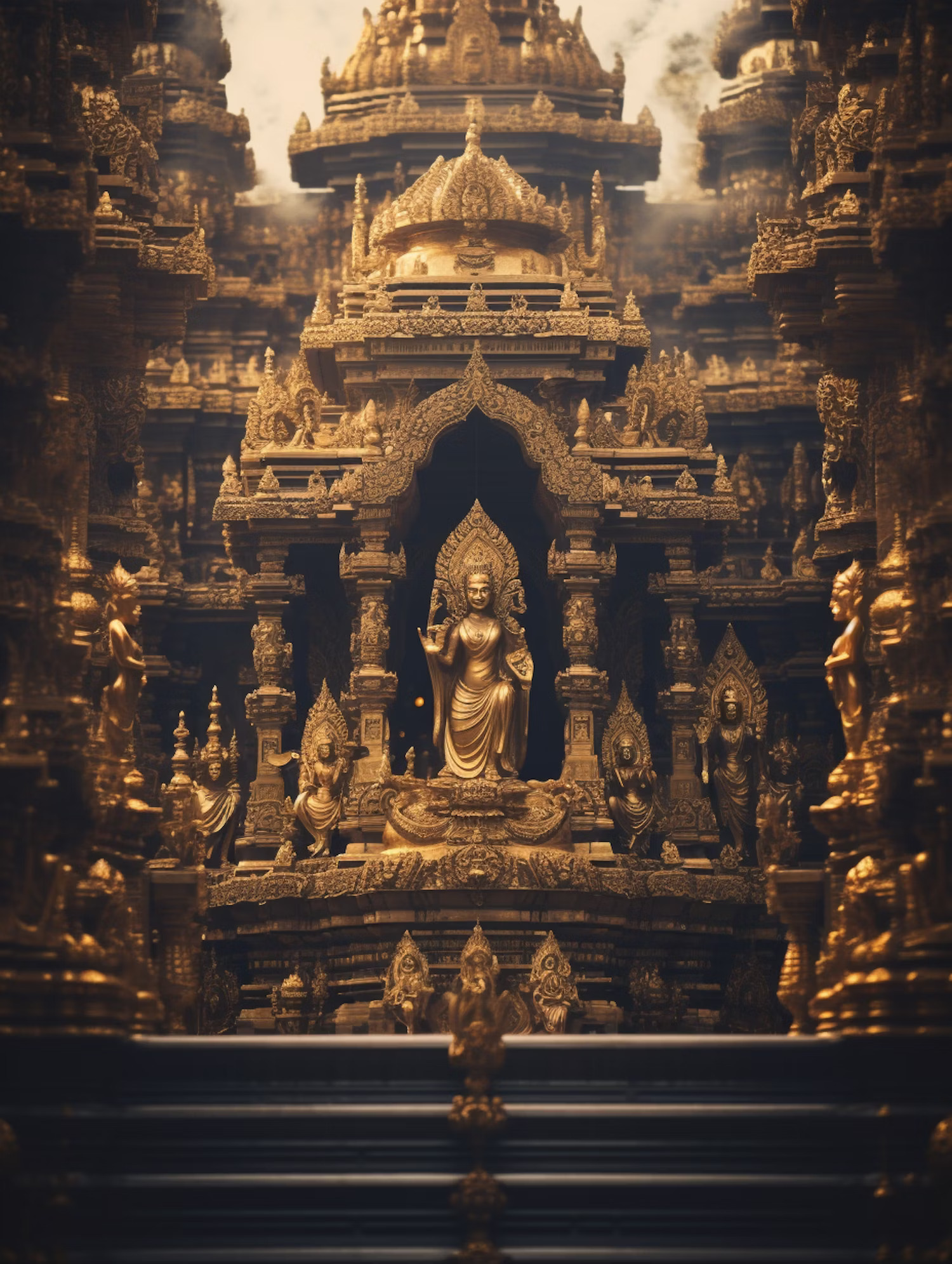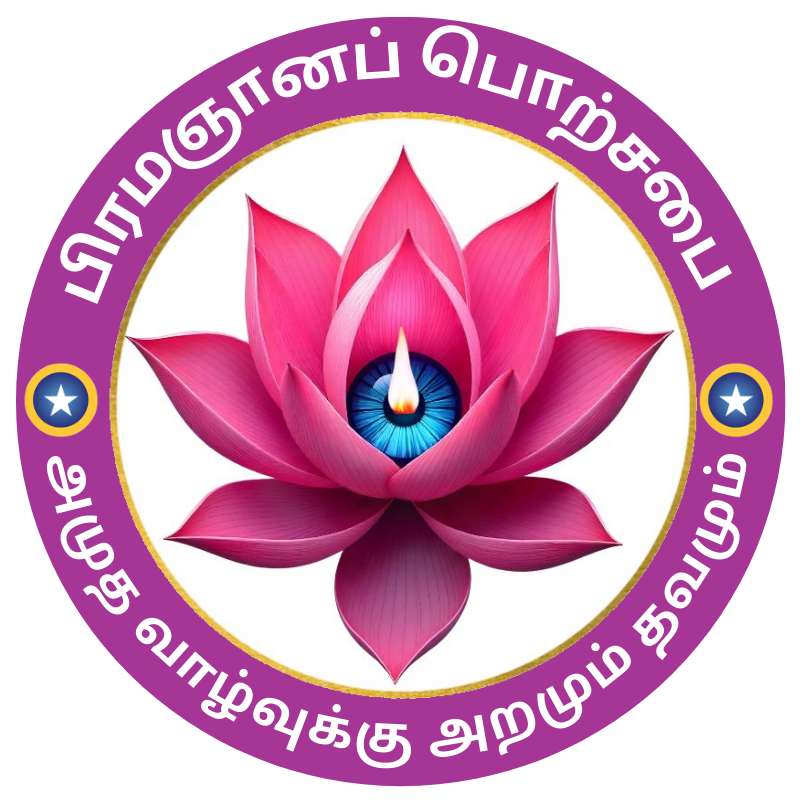BramaGnana Porsabha Peedam Education
Countless souls are wandering the world in search of wisdom. The number of human lives yearning and striving to find wisdom in every place is beyond measure.
In ancient times, gurukulam education flourished with excellence all over our holy land of India. Sages, saints, and rishis conducted such gurukulams, imparting Brama Gnana (divine knowledge). During the British era, all these gurukulams were destroyed. Countless gurus were killed. As a result, the lineage of the gurukulams vanished. To change this situation and to establish a gurukulam that would again impart the ancient Tamil Siddha knowledge taught by our true gurus, it is essential for people worldwide to fully receive and immerse themselves in Brama Gnana. With this long-term vision, we have been running the Brama Gnana Gold Sabha Gurukulam in the city of Salem, Tamil Nadu, India, since 2021.
As the Thiruvasagam verse says:
“When the time comes, be prepared with love and righteousness.
The world was created,
with Brama and the devas not understanding its essence.
The one who consumed the poison,
our Pandya lord, Is now bestowing the ancient treasures to his devotees.
Come and receive them first.”(Thiruvasagam)
“O fools who see with the eyes on your face,
True bliss is seen with the eyes of the soul.
How can I describe the joy Of the mother dancing with her beloved child?”(Thiru Mandiram 2944)
“With the rise of love that arises in union,
The Lord, who arises in love,
The benevolent guru comes and places his hand on your head,
And the blessed guru’s grace enters your heart.”(Thiru Mandiram 1590)


The Importance of the Guru in Saiva Tradition: Understanding True and False Gurus
The basic principle is that for a person who does not know to clearly understand a subject, someone who knows must inform them. The idea that education is not possible without a teacher, and knowledge is not attainable without a guru, is rooted in the Saiva text, the Thirumanthiram. This text emphasizes the role of the guru in the process of learning, and reveres the guru as equivalent to the divine.
However, the Thirumanthiram cannot be generalized in that way, because it is a religious text specific to Saivism. The knowledge it aims to impart is not general knowledge but the specialized wisdom upheld by the Saiva tradition. Only those who have comprehended and realized the special knowledge of the Saiva tradition can impart it, not just anyone.
Thirumanthiram, Verse 1567:
“Saiva Samayath Thani Nayagan Nandi
Uyyya Vaguttha Guruneri Ondrundu
Deivas Sivaneri Sanmaarkkam Serndhuyya
Vaiyaththu Ulaarkku Vagutthu Vaiththaaney”
The supreme lord of the Saiva tradition, the one and only leader, Nandi, has established a path of the guru for the salvation of all beings in the world. This path is the divine path of Shiva, the righteous path known as Sanmaargam, the path of Saiva wisdom.
When it is generalized that one who seeks knowledge can obtain it from anyone who possesses it, there is no problem. However, one who lacks humility becomes a blasphemer.
In the matter of selecting a guru, Thirumoolar’s intention is that no one should be troubled. Choosing the wrong guru wastes an entire birth. Therefore, Thirumoolar clearly explains who is a true guru and who is a false guru.
Thirumanthiram, Verse 2044:
“A person without insight, one who does not grasp the truth,
One who cannot see the path of the Vedas and Agamas,
One who lacks humility and blasphemes others,
Such a person, with the nature of a speck, is indeed a false guru.”
Identifying the True Guru in Saiva Tradition
Even if one possesses knowledge, Thirumoolar identifies the false guru, or asarguru, as someone who lacks insight and engagement, fails to understand the truth in its entirety, and does not penetrate the essence and core meaning of fundamental texts, even if they can recite them verbatim. A false guru is also someone who lacks humility, criticizes other paths while praising their own, and possesses arrogance as a fundamental trait.
So, who is the true guru, or sarguru?
Thirumanthiram, Verse 2052:
“A true guru is one who, devoid of attachments, seeks the supreme with love and removes the impurities of those who come to him with a desire for knowledge. He is someone who, not only contemplates the divine but also introspects himself. He lovingly imparts his method of introspection to those who seek him, ensuring their impurities are entirely eliminated and do not return. He is devoid of desires, meaning he has no attachment to anything. Such a person is the true guru.”
Thirumoolar distinguishes between true and false gurus, asserting that a true guru is not one who relies on outward appearance, verbal eloquence, loud voice, or the ability to win arguments. A true guru does not seek to establish their stance through debates. Thirumoolar makes it clear that:
Thirumanthiram, Verse 242:
“Those without true knowledge, who wear matted hair and sacred threads, pretending to be wise sages, should be tested by the truly wise. Ensuring true knowledge prevails is beneficial for the land.”
These verses emphasize the necessity of discerning true spiritual guides from impostors, highlighting the attributes of a genuine guru and the importance of wisdom and humility in the Saiva tradition.

People without true wisdom, who wear robes, ochre garments, and holy threads like scholars, act like knowledgeable ones. They must be investigated by learned ones to determine if they are indeed true scholars. By investigating thus, either true wisdom must be instilled in those false scholars, or they should be shown the falsehood of the guru’s deceit to those who believe in them like slaves. This is what Thirumoolar claims is beneficial for the land.
What does it mean by ‘guru-neri’ (guru’s path)? That is the path shown by the guru; the path indicated by the guru; that is, the great path of the guru. ‘Path’, ‘way’, ‘dharma’, ‘guidance’, all signify the same thing.
In worldly matters, for obtaining perfection, we need someone superior to us in knowledge, conduct, God’s path, wisdom, and divine attributes to guide us. No one can deny this. Indeed, the whole world is based on learning. It is only through learning, believing in the truth, and following its path that worldly life becomes meaningful today. Therefore, for those inferior to such learning, it is only through the compassion of those superior to them, manifesting the truth and light, that they can progress.
We must understand that there is one true path amidst paths that are not paths. That is why it is said to blossom like the nelumbo from the muddy water. Since it is impossible to transform non-paths into paths, the path of true wisdom, which becomes the path of truth, is like the lotus stem growing amidst the muddy waters.
“I have realized the path that is not a path as a path,
And the beautiful grace, where small paths don’t meet, is yours,
Even the fragrance of your feet, unknown to me,
Will be received, oh gracious one!”
(Thiruvasagam – Achchoppadigam – Song 2)

Understanding the Essence of the Guru
For all seekers, for all human souls, the essential and fundamental path to be followed is the common path of truth, which is the responsibility of all.
Who is a guru? He is the one who removes our sins; the one who removes sinful actions – that is, the one who removes dirt and the dirtiness of sins; the one who removes impurities – these are the meanings implied. Therefore, the one who removes obstacles and creates joy is called a guru.
The divine, which exists within our human souls as the essence of joy, manifests itself as the supreme truth, becoming our guide, our guru, showing us the right path for our actions to be taken forward. Whatever stage of life one may be in, that is the guru suitable for them. Whether one is a beginner or has progressed in life, the guru adapts and guides them accordingly. This is true in both spiritual and worldly contexts. Therefore, the relationship between the guru and the disciple is established through truth.
Guru, Aasaa, and Purohitan are synonymous terms. Aasaa means the one who shows the righteous path, who guides towards virtuous ways, and who shows the path of true knowledge. Purohitan means the one related to puram, meaning place, body, and attire. In the Tiruvaaymozhi, the term ‘puram’ indicates the body, which is portrayed as the attire.
We are souls residing within the body – the immortal body itself is called the chariot. The head, which serves as the capital for the body identified with the city of puram, is essential for the body and soul to experience joy. The one who performs this essential function for the body identified with puram, facilitating the experience of joy for body and soul, is the Purohitan. Isn’t this what Tiruvasagam indicates as ‘the chariot that doesn’t tire, the one who guides without exhaustion, who instructs with good advice for our well-being’? Isn’t that a Purohitan?
The Vedas, Agamas, Puranas, and other noble scriptures all affirm that the eternal truth, which leads humanity from birth to liberation, is one and the same. They declare that the guru, who reveals this truth, is none other than Nandi, the vehicle of Lord Shiva, who uplifts us from the cycle of birth and death. Lord Nandi, who bears the weight of the universe, is the ultimate guru who imparts divine knowledge. This is beautifully expressed in the Tirumandiram:
‘Nandi, the leader of the Shaiva tradition,
Has established the eternal path,
By uniting with the divine knowledge of Shiva,
And guiding seekers on the path to liberation.’
Even if I have attained knowledge through other means, I have always sought refuge in the divine grace of the benevolent guru, who, like a compassionate mother, has lifted me from the depths of the ocean of sin, ignorance, and delusion, even during the darkest times, when my mind was immersed in the ocean of worldly attachments and desires.
The scripture further explains:
‘The guru who dispels suffering and bestows joy
Is the true savior of souls.
Suffering, fear, and confusion
Are like the dangerous sea,
But the guru is the steady boat
That carries us safely across.’
Fear, worry, and doubt are like waves in the ocean of worldly existence. The impurities within the body give rise to diseases, afflictions, and sorrows. This is the nature of the world – the realm of impermanence. Therefore, overcoming fear, worry, and doubt leads to the attainment of joy and serves as the foundation for human endeavors. Overcoming fear is like dispelling darkness; it removes all sufferings. Just as the lotus blooms in muddy water, joy emerges when fear is dispelled.
The Tiruvachakam also beautifully portrays the concept:
‘Like a black snake coiled around a stick,
Desire wraps around the cycle of birth and death,
But righteousness, like a mongoose,
Has bitten and killed me.’
Thus, righteousness and sin are the two fears. Overcoming them leads to my salvation.”
This text elucidates the significance of the guru as the guide who leads individuals from darkness to light, from ignorance to knowledge, and from suffering to liberation.
Transforming Life’s Medicines into Divine Remedies
What is the medicine that has become the disease of this birth? – It is the medicine that removes impurities, that is called God’s chariot, the divine nectar. Thiruvalluvar also praises God as medicine in the seventh couplet, saying, ‘Without self-discipline, it is hard to get relief from the torment of the heart.’ It means that those who have obtained the divine chariots, the ones who have not connected themselves to anyone, are free from the sorrows that arise in the minds of others.
Thiruvadi refers to the hidden essence within us human beings – as the hidden substance – as the treasure trove of virtue. It is the practice of purifying the body and mind from the sorrows, physical and mental, which leads to eternal bliss. Transformation is sorrow itself. Sorrow gives birth to delusion – to desire, pleasure, and knowledge. We must understand the truth of the Vedas to overcome it all.
Through the method of overcoming, without giving in to temptation,
Like a healer who overcomes the disease of delusion,
Like one who removes the distress of poverty,
Everything becomes the essence of bliss. (Tirumantiram 2422)
Who is the true guru who reveals these divine chariots? He is the one who, like the ultimate ocean of compassion, completely understands our discipline, making us sweet-seeming beings, who, by completely understanding the karmic bonds and their attendant sorrows, overcome the lowly sorrows of good and evil deeds, turning them into pure blessings, and becoming a great healer who removes and purifies us of diseases like ignorance, desire, delusion, and birth.

How does one attain the grace of the Guru Natha? Can those who possess wisdom and compassion, like the great Vallasala who lovingly embraces accomplished beings, still fail to recognize the souls who have attained the state of grace? If a flower blossoms, must someone invite the bees? Just as bees seek out flowers to make honey, seekers of truth also come seeking those souls who have attained grace, and the gurus guide them, bestowing wisdom. This is the natural order of divine grace and knowledge.
What does Guru Natha teach those who receive his grace? In the book of wisdom known as “Suddhasadhaka,” the numbers 70, 71, 76, 78, 80, 82, and 90 hold significance. I seek to explore these teachings. Whether it’s “Sivaya Namah” or “Narayanaya Namah,” these words are not merely recited by the mouth of the guru. Instead, through the sacred practices conducive to realization, the guru imparts the true meaning and the practical methods for attaining it. By the grace of the guru, the practices and yogas imparted lead to the realization of the truth, as expressed in the chants “Sivaya Namah” and “Narayanaya Namah.” Periyava, in his songs, conceals the essence as a hidden meaning and reveals it through his grace, using the sacred symbols of “Sivaya Namah” and “Narayanaya Namah.”
The usefulness of the guru’s guidance is what? It can dispel the darkness of ignorance.
“One must not stay where the palm leaf roof is old, nor where the food is spoiled,” it is not necessary to stay where the roof is old. (Tiruvasagam, p. 55)
“It is not necessary to stay where the palm leaf roof is old,” the one who has the palm leaf roof. (p.56)
This impure body can be cleansed. (above, p.64)
Remove this old palm leaf roof and go to your own home. (above, p.100)
This body itself can be shed. (Cettilappadu, p.2)
One can dispel the illusion of disease. (above, p.5)
Due to the severity of the actions, if one does not obey, they will not get peace; The body that has suffered from the severity of the actions will be destroyed, will be peaceful, will be full, will be enlightened. (Tiruvannamalai)
Forget the greed for money and serve the Lord; The body that is relieved of service is like a bird that has been released from its cage. The body that has been relieved of service will be blessed; Alam will become nectar; Mercy will become abundant. (Tiruvandapakuti)
Because of the cleansing of the body caused by the lack of wealth, the body becomes a flying machine.
Karuvur
When the body is cleansed like the earth that has been rubbed by the plow and becomes fragrant, the impure body becomes like the earth rubbed by the plow.

The Spiritual Wisdom of tiruvasagam and Avvai Gnanakural
Tiruvasagam
Karanas have all passed through the ears of the creator
Even these feet have come to me
Death is the illusion of these two
Compassion to the ocean and back to the pot
Avvai Gnanakural
“Looking down the nose at the navel,
There is no death for the body.” (Kannadi, stanza 3)
“In the full light of the eyes,
The body will not perish.” (Eye, stanza 8)
“After realizing with wisdom,
There is no death for the body.” (Suni-aridhal, stanza 6)
“When you look inside evil,
The body is not the next.” (Suni-aridhal, stanza 7)
“Understanding the substance from birth to death,
The body will not perish.” (Su, stanza 9)
“If you think about the property you own,
The body will not perish.” (Su, stanza 10)
In this way, if one transforms the body through fasting, it becomes a permanent asset. The evidence that confirms the true nature of the teachings of the guru is found not only in the Vedas but also in other scriptures of wisdom. All of these can be read and enjoyed there.
As stated above, “I can dispel the darkness of ignorance,” the foremost among these evidences is the activity of changing this impure body into an eternal, auspicious form, which is the benevolent action of divine grace for the sake of serving the Lord. In those times, despite the countless troubles faced by him, and then, having obtained the permanent nature of his actions, he will shine brightly. It is necessary to understand the usefulness of a true guru’s guidance.
So far, what has been said is that this is the true guru’s guidance, and the Lord, who is the protector of that guidance, is none other than the Supreme Being, who is the caretaker of Shaivism. The benefit of that guidance is only realized when eternal truth is attained. We now understand this well, don’t we?
Lessons from the Gurukula Tradition
If you wish to attain the everlasting truth of immortality, then you must seek the guidance of the Guru who has acquired both eternal wisdom and practical experience. This is because only through such wisdom can one overcome the hurdles of illusions and reach the state of eternal truth. The Guru, akin to Lord Shiva, provides the means and methods, the essence of wisdom, and the path to true knowledge, guiding you to seek what you need from the divine. Praising the wisdom, they teach and remind everyone to honor wisdom, and thus, we conclude this discourse on wisdom. In this Gurukula education, students are taught wisdom at every stage. The following are all taught as foundational lessons:
Lesson 1: What is the Guru Principle? What is the technique to attain it?
Lesson 2: Who am I?
Lesson 3: The 96 Elements within the Body
Lesson 4: Functions of the Ten Vital Airs
Lesson 5: 96 Elements in Tamil
Lesson 6: How to seek God within oneself first?
Lesson 7: How to realize the truth within oneself?
Lesson 8: What is good behavior?
Lesson 9: What are the benefits of the body?
Lesson 10: The benefits of the body in Avvai Gnanakural
Lesson 11: The Secret of Nadha Bramam
Lesson 12: The Secret of Valalar Oli Thegam and the path to true knowledge
Lesson 13: Opening of the Third Eye – Tiruvandpa (Exposition of Wisdom)
Lesson 14: The Tenth Insight – Tiruvasagam (Exposition of Wisdom)
Lesson 15: Ecstasy of the Third Eye – Tiruvandpa (Exposition of Wisdom)
Lesson 16: The Secrets of the Eye Meditation
In the aforementioned numerous topics, wisdom and the teachings of the ancient Tamil Siddhas about how to attain wisdom, and the methods to embrace wisdom are taught in detail, providing clarity and enlightenment to the students.
May all beings live in bliss!
Tiruchittrambalam!


